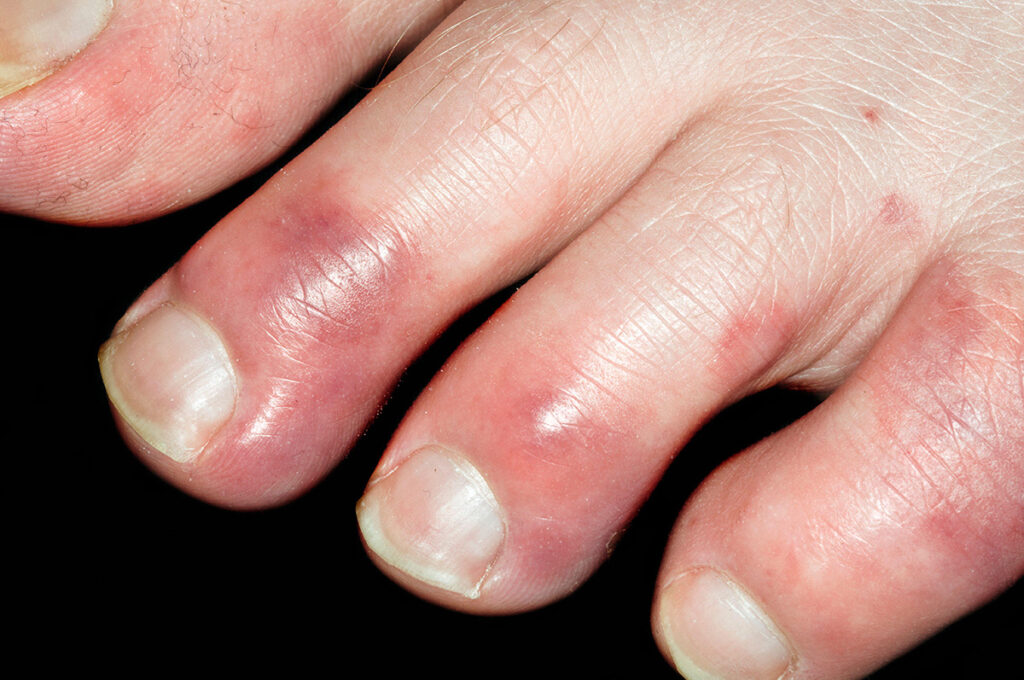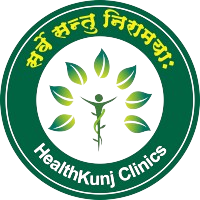Chilblains - Symptoms, Causes, Prevention & Homeopathic treatment

Overview
Chilblains, also known as pernio, are painful, itchy, and swollen areas of the skin that occur due to an abnormal reaction to cold and damp conditions. They most commonly affect the fingers, toes, ears, and nose. Chilblains are a common condition in colder climates and can be uncomfortable and distressing. Understanding the causes, symptoms, and treatment options is essential for effective management and relief.
Symptoms
Chilblains present with several characteristic symptoms:
- Red or Purple Skin: Affected areas may appear red, purple, or blue and can be swollen.
- Itching and Burning Sensation: Itching and a burning or stinging sensation are common.
- Pain: Pain in the affected areas can range from mild to severe.
- Swelling: Swelling is typically localized to the fingers, toes, ears, or nose.
- Skin Changes: In severe cases, blisters or ulcers may develop on the affected skin.
Symptoms usually appear after exposure to cold and damp conditions and can worsen with further exposure to cold.
When to See a Doctor
Seek medical attention if you experience:
- Persistent Symptoms: Symptoms do not improve with self-care measures or worsen over time.
- Severe Pain: Severe pain or significant swelling in the affected areas.
- Skin Changes: Development of blisters, ulcers, or signs of infection.
- Systemic Symptoms: Fever, chills, or other systemic symptoms accompanying the chilblains.
Early diagnosis and treatment are crucial to prevent complications and manage symptoms effectively.
Causes
Chilblains occur when the skin is exposed to cold and damp conditions, causing an abnormal reaction in the blood vessels. The exact cause is not fully understood, but the following factors contribute:
- Cold Exposure: Prolonged exposure to cold, damp weather or environments.
- Rapid Warming: Rewarming the skin too quickly after exposure to cold can trigger chilblains.
- Poor Circulation: Impaired blood circulation can increase susceptibility to chilblains.
Chilblains are not caused by frostbite, though they may occur alongside or be mistaken for frostbite in severe cold conditions.
Risk Factors
Several factors increase the likelihood of developing chilblains:
- Climate: Living in cold and damp climates increases risk.
- Previous History: Previous episodes of chilblains or similar conditions.
- Poor Circulation: Conditions that impair blood flow, such as peripheral vascular disease.
- Lifestyle Factors: Wearing inadequate clothing for cold weather or spending prolonged periods in cold environments.
- Gender and Age: Chilblains are more common in women and younger individuals, though they can affect anyone.
Complications
If left untreated or poorly managed, chilblains can lead to complications:
- Infection: Open sores or blisters can become infected.
- Skin Damage: Persistent chilblains may lead to skin damage and scarring.
- Poor Healing: Chronic chilblains may result in poor healing or recurrent episodes.
Preventions
Preventing chilblains involves taking measures to avoid cold exposure and maintaining good skin and circulation health:
- Avoid Cold and Damp Environments: Limit exposure to cold and damp conditions, especially during winter months.
- Wear Warm Clothing: Use warm, layered clothing and insulated gloves and socks.
- Gradual Warming: Rewarm your skin slowly after exposure to cold, avoiding rapid changes in temperature.
- Improve Circulation: Engage in regular physical activity to promote healthy circulation.
- Moisturize: Keep skin well-moisturized to maintain its health and resilience against cold.
Can Homeopathy Help?
Homeopathy offers a holistic approach to managing chilblains by addressing the individual’s unique symptoms and overall health. Homeopathic remedies are selected based on the patient’s specific presentation and constitutional type. Common homeopathic remedies for chilblains include:
Homeopathic Remedies for Chilblains
- Arsenicum Album: For chilblains with burning pain, restlessness, and symptoms aggravated by cold.
- Calcarea Carbonica: For individuals who are chilly and prone to cold-related issues, with a tendency to develop chilblains.
- Rhus Toxicodendron: For itchy, burning chilblains that improve with warmth and movement.
- Hepar Sulphuris: For chilblains with pus formation or infection and a tendency towards extreme sensitivity to cold.
- Vinca Minor: For chilblains with severe itching and burning sensations, particularly in cold and damp conditions.
A homeopathic practitioner will tailor the remedy based on a detailed assessment of the patient’s symptoms and overall health.
Diagnosis
Diagnosis of chilblains typically involves:
- Medical History: A review of symptoms, exposure to cold conditions, and previous episodes.
- Physical Examination: Evaluation of the affected skin areas to identify characteristic symptoms.
- Exclusion of Other Conditions: Rule out other skin conditions or systemic issues that may mimic chilblains, such as frostbite or peripheral vascular disease.
In some cases, additional tests may be necessary to assess circulation and rule out underlying conditions.
Treatments
Treatment for chilblains focuses on alleviating symptoms and preventing further episodes:
Conventional Treatments
Topical Treatments:
- Steroid Creams: To reduce inflammation and itching.
- Antiseptic Creams: To prevent infection in open sores.
Pain Relief:
- Analgesics: Over-the-counter pain relievers, such as ibuprofen or acetaminophen, can help manage discomfort.
Warming Measures:
- Warm Compresses: Applying warm compresses to affected areas to soothe pain and improve circulation.
- Gradual Warming: Slowly rewarming the skin after exposure to cold.
Homeopathic Treatments
Homeopathic remedies can complement conventional treatments and support overall well-being:
- Arsenicum Album: For burning pain and restlessness, often aggravated by cold.
- Calcarea Carbonica: For individuals prone to cold-related issues with a tendency to develop chilblains.
- Rhus Toxicodendron: For chilblains with itching and burning that improve with warmth.
- Hepar Sulphuris: For chilblains with pus formation and extreme sensitivity to cold.
Lifestyle Adjustments
Incorporating lifestyle changes can help manage and prevent chilblains:
- Maintain Warmth: Keep affected areas warm and dry, especially in cold weather.
- Avoid Rapid Temperature Changes: Rewarm skin gradually after exposure to cold.
- Regular Exercise: Promote healthy circulation through regular physical activity.
Preparing for Your Appointment
To make the most of your appointment, consider the following:
- Symptom Record: Keep a detailed record of symptoms, including their onset, duration, and triggers.
- Medical History: Provide comprehensive information about previous medical conditions, family history, and current medications.
- Cold Exposure: Document instances of cold exposure and related symptoms.
- Questions: Prepare questions about treatment options, potential side effects, and management strategies.
- Support System: Involve family members or caregivers in the appointment to discuss care strategies and support.
